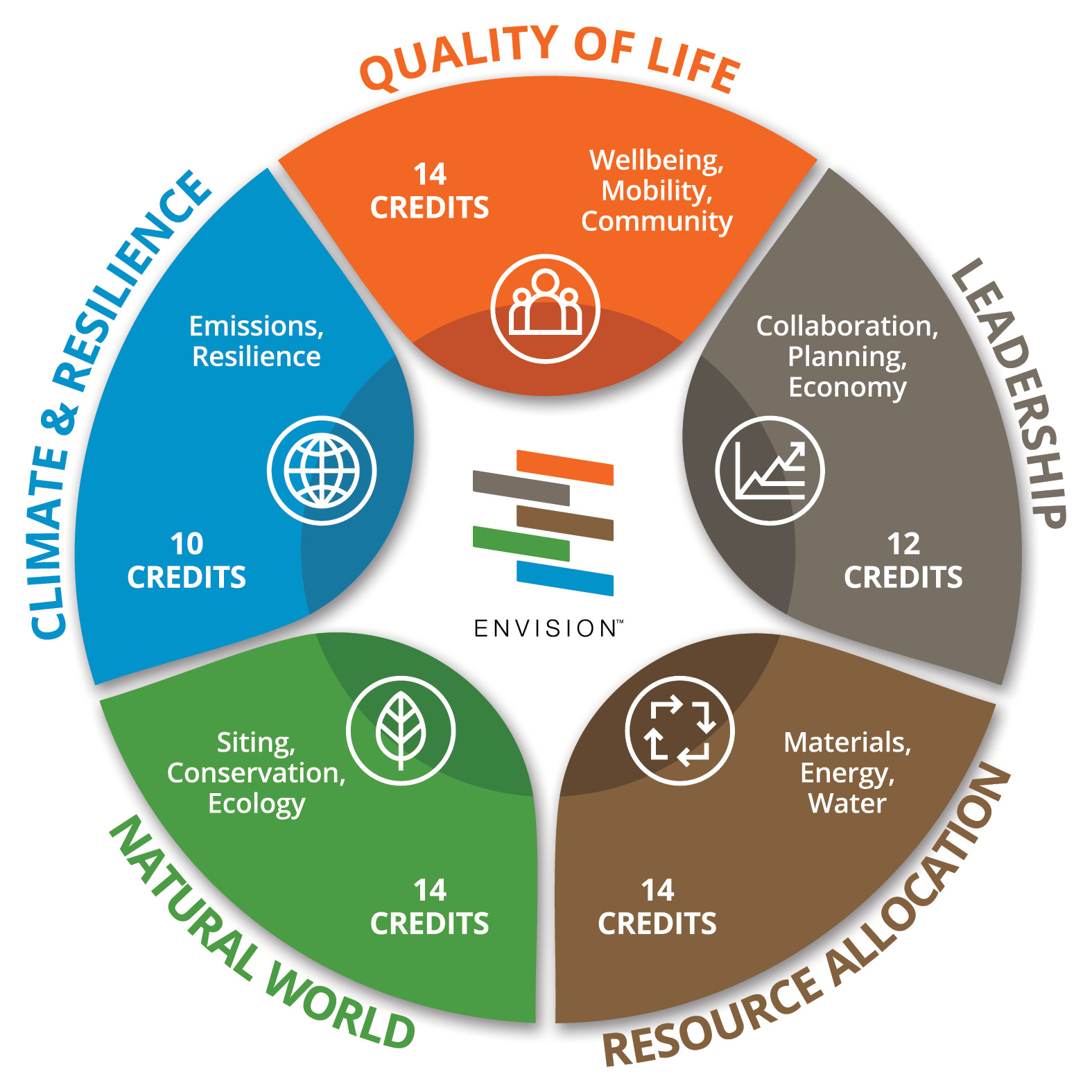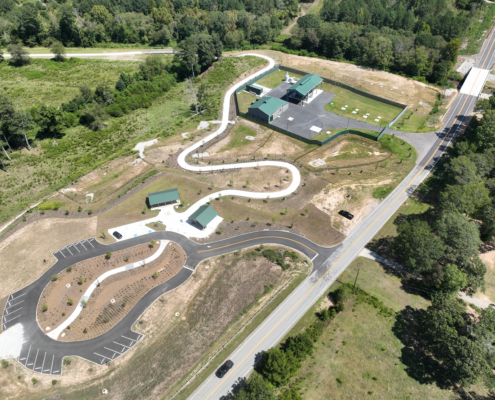The term “sustainable development” was defined nearly 30 years ago by the United Nations Brundtland Commission as “meeting the needs of the present without compromising the ability of future generations to meet their own needs.” However, people often give the term their own meaning, largely due to context, leading to confusion/misunderstandings about its intent and application. One purpose of ISI’s Envision Sustainable Infrastructure Framework is to provide a common language for sustainability in infrastructure to support project team collaboration and facilitate clear communication with the stakeholders. Envision is a framework and rating system designed to help infrastructure stakeholders implement more sustainable, resilient, and equitable projects. Envision includes 64 sustainability and resilience indicators, called ‘credits’, organized around five categories. Each credit includes criteria questions to help project teams examine options for incrementally improving a project’s sustainable performance.
As ISI works to advance sustainable, equitable, and resilient infrastructure through the use of Envision, we’ve run into various myths, or misconceptions, about sustainability and Envision application. In the APWA Reporter March 2025 issue, we address one in the article “Applying sustainability tools benefits projects with small teams and small budgets,” but there are many more misconceptions to dispel. We delve into five myths below, and for each myth, we explored projects in the verification program and industry context. We also asked for feedback from representatives who are working with the Envision framework on a daily basis.
Myth: Sustainable infrastructure is a trend.
Sustainable development is not a “fashion” or “fad” that may stop or fade. It is, however, something that is constantly evolving, developing, and changing. The fact that this topic isn’t going away, is demonstrated through the growth of frameworks like Envision. At the end of 2024, the program included more than 400 projects with a cumulative value over $283 billion (USD) – a 40% increase in projects and 60% increase in cumulative value over the last two years.
Envision Sustainability Professionals (ENV SPs) from Hazen and Sawyer commented that “Sustainable infrastructure represents a long-term investment in assets that not only align with the natural environment in which they exist but also adapt to meet the evolving needs of communities under changing conditions. Increasingly, we are seeing municipalities recognize and embrace the importance of embedding sustainability into their operations. This shift is reflected through integrated planning, cross-departmental collaboration, and the adoption of robust policy frameworks. Because infrastructure, by its very nature, is designed to endure over time, it is inherently sustainable; for example, portions of New York City’s drinking water system date back to the mid-1800s. These principles, coupled with the direct link that infrastructure has to societal benefits such as job creation and communal connectivity, underscore the permanent nature of sustainable infrastructure.”
“Sustainable infrastructure represents a long-term investment in assets that not only align with the natural environment in which they exist but also adapt to meet the evolving needs of communities under changing conditions.”
– ENV SP, Hazen and Sawyer
The sustainability community’s advancement of methods, tools, and practices is illustrated through Envision projects and highlights topics that have a current emphasis, like multi-benefit infrastructure and carbon reduction. For instance, the Eastern Regional Infrastructure Project of Gwinnett County, Georgia, which addressed critical community needs related to water, sewer, and trail infrastructure, recently received an Envision Silver award. The project co-located a new five-mile trail system with the gravity sewer line, effectively integrating civil infrastructure with a community recreation asset. The City of Santa Monica Sustainable Water Infrastructure Project, which was verified Platinum in May 2024, reduces the city’s traditional reliance on costly imported freshwater resources from Northern California and the Colorado River by creating new, local water supplies. The project reduces the water-supply carbon footprint due to the advanced water treatment plant and all components of the SWIP Project operating via 100% renewable electricity, obtained through the city’s Direct Access agreement with the Clean Power Alliance.
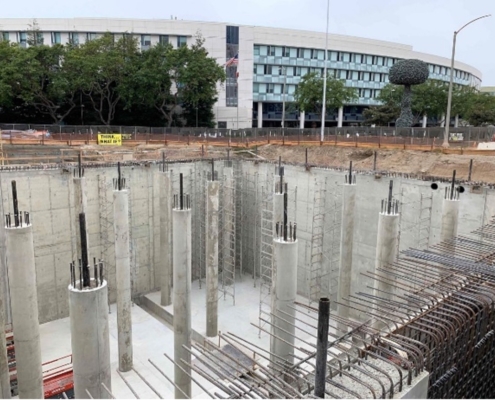
City of Santa Monica Sustainable Water Infrastructure Project, Santa Monica, California (Envision Platinum v3, 2024)
Will Kirby, PE, ENV SP, a Transportation Sustainability Leader and Envision Practice Lead with HDR noted, “Infrastructure investment is typically something most politicians and leaders can agree is necessary. They may disagree on why: job creation, economic growth, community function, resiliency, or other reasons like scoring political points. Unfortunately, many leaders may not have the same motivation for sustainable infrastructure development. Fortunately, and sometimes unfortunately, there are other societal and climate shifts that are necessitating sustainable infrastructure. Communities are demanding to repair connections via infrastructure, not fracture communities. Natural disaster frequency is requiring more resilient infrastructure. Regulations are requiring less emissions during construction and operations. While certain elements of sustainable development may shift, the overall trend will continue toward more sustainable and resilient infrastructure.”
“While certain elements of sustainable development may shift, the overall trend will continue toward more sustainable and resilient infrastructure.”
– Will Kirby, PE, ENV SP, Transportation Sustainability Leader, HDR
Myth: Sustainability is only about the environment.
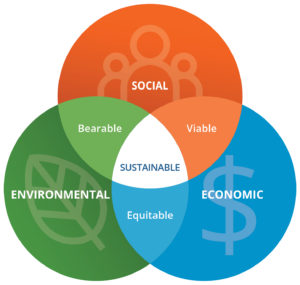
Triple bottom line
While topics like recycling and emissions might be seen more often in media, from an organizational standpoint sustainability is often defined using the triple bottom line, which puts equal emphasis on economic, environmental, and social factors. As a decision-making guide, Envision provides industry-wide sustainability metrics for all types and sizes of infrastructure to help users assess and measure the extent to which their project contributes to conditions of sustainability across the full range of social, economic, and environmental indicators – or triple bottom line.
Justin Waples, Infrastructure Strategic Planning Engineer with Central San, notes that “As engineers, when we put together scope for projects, it is primarily focused on addressing a specific infrastructure asset performance or regulatory risks, and often from a perspective that typically involves looking back at past risks to shape future project thought foundations. Envision encourages us to look ahead, to look further, and deeper at a greater range of risks: both opportunities and challenges. Envision encourages diverse stakeholder input, and from those diverse perspectives will come solutions that will not only meet the immediate needs of today; but help future proof the infrastructure when it is still in service 50 to 100 years from now. To me as an engineer, the phrase ‘sustainable’ infrastructure means not only thinking about the environment, but also thinking about the long-term operational sustainability of the asset, in terms of performance and resiliency during unplanned for emergencies. Emergencies which can disrupt short and or long-term supply chains, transportation routes, critical natural resources, and public health and safety. If you want to mitigate those risks for your infrastructure, then consider using Envision.”
“To me as an engineer, the phrase ‘sustainable’ infrastructure means not only thinking about the environment, but also thinking about the long-term operational sustainability of the asset, in terms of performance and resiliency during unplanned for emergencies. Emergencies which can disrupt short and or long-term supply chains, transportation routes, critical natural resources, and public health and safety. If you want to mitigate those risks for your infrastructure, then consider using Envision.”
– Justin Waples, Infrastructure Strategic Planning Engineer, Central San
ENV SPs from Hazen and Sawyer stated that “The core principle of sustainability is its emphasis on balancing multiple benefits rather than focusing on just one. By integrating social, economic, and environmental outcomes, sustainability provides solutions and decision-making frameworks that address diverse needs. The benefits of sustainability extend across areas such as human health, environmental health, affordability, community well-being, equity, and quality of life—both for current and future generations. This approach shifts decision-making to prioritize maximizing the net benefit for the entire community through collaboration and stakeholder involvement, moving away from narrowly focused solutions. For instance, consider a partnership between a utility provider and a local artist to produce a mural on a pump station wall. This enables the provision of an essential wastewater service while also contributing to community views and character. Additionally, the involved stakeholders become more mutually aware of each other’s contributions to the local community.”
“The benefits of sustainability extend across areas such as human health, environmental health, affordability, community well-being, equity, and quality of life—both for current and future generations.”
– ENV SP, Hazen and Sawyer
Resilient and Sustainable Engineering with Port Authority of New York and New Jersey (PANYNJ) shared that “Sustainability is not only about the environment but instead the entirety of the natural world, including humans. Sustainable development is the delicate balance between the built environment and the efficient use of resources, preservation of ecosystems, habitat, jobs, and culture. The key to overall sustainability is understanding the limits of our planetary boundaries and strategizing the use of resources for balanced growth and limiting or eliminating waste. ISI’s Envision framework helps projects develop sustainable strategies that enable them to operate within the Earth’s planetary boundaries by evaluating projects through the lens of environmental, social, and economic considerations.”
“Sustainable development is the delicate balance between the built environment and the efficient use of resources, preservation of ecosystems, habitat, jobs, and culture.”
– Resilient and Sustainable Engineering, Port Authority of New York and New Jersey
Myth: Using Envision to guide sustainability is only beneficial on new projects (not renovation / upgrade / improvement projects).
To look at this myth, we need to take a step back to the decision to build new vs. renovate/upgrade. A basic tenet of Envision is that it not only asks, ‘Are we doing the project right?’ but also, ‘Are we doing the right project?’ It is important to include a range of sustainability criteria beginning at project conception, to ensure triple-bottom-line considerations factor into project prioritization, comparing project alternatives, and building consensus around the best project solution. Early application of Envision provides value by introducing a range of sustainability topics into the decision-making process. In addition, it can be used to assess community values, engage stakeholders, and guide decisions for defining a project scope.
If the project team decides to renovate or upgrade, the Envision framework can be applied throughout planning, the design process, and construction to improve the project process, facilitate discussion of design alternatives to improve sustainable performance, and integrate sustainable considerations into construction. Some considerations are different when looking at a new project vs. an improvement project, but for both project types Envision credits and criteria help project teams evaluate the full range of sustainability and resiliency factors.
Akima Cornell, PhD, ENV SP, Principal with Akima Consulting, LLC, notes, “Using Envision is beneficial for renovation or improvement projects, where newer aspects of a project need to be integrated with existing infrastructure and technologies. Envision’s holistic approach helps a project to assess the current infrastructure, stakeholders, and environmental conditions which can change over the lifetime of the infrastructure. An existing wastewater treatment plant needed an upgrade. When it was originally built the plant was located outside city limits. Yet, over time the city expanded and is now surrounded by buildings. Utilizing Envision, the project team can not only evaluate the capacity and structural change needs of the plant, but also the needs of the new surrounding community.”
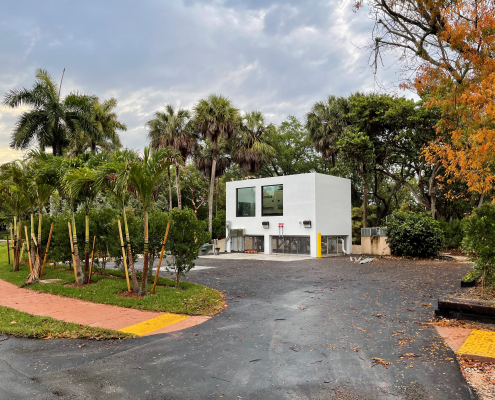
Cocoplum 1 Pump Station Project, Coral Gables, Florida (Envision Bronze v2, 2022)
The Cocoplum 1 Pump Station in Coral Gables, Florida, is an example of an Envision-verified upgrade project. The city performed various mechanical, electrical, and structural upgrades to Cocoplum 1 Pump Station – one of 35 wastewater pump stations in the city’s wastewater conveyance system – to proactively upgrade the wastewater system to better handle peak flows and improve overall system reliability.More than 150 homes in the basin, and another 100 properties in collection basins that are re-pumped by this station, rely on Cocoplum 1 Pump Station to function optimally. The project used proactive and inclusive stakeholder engagement that resulted in meaningful design changes. Key issues raised by project stakeholders included pump station flooding, disturbances during construction, pump station operations and maintenance, and the inclusion of infrastructure improvements beyond the pump station itself.
Aerin Klump, PE, ENV SP, a Mechanical Engineer with HDR, offered “Constructing entirely new, sustainable infrastructure is often unrealistic in densely urbanized areas like New York City. The NYC Department of Environmental Protection has successfully navigated these challenges by integrating the Envision framework into standard operating procedures (SOPs) on all agency projects, such as upgrading systems at existing water reclamation facilities. These SOPs have led to sustainable design improvements including use of recycled or reused materials, enhanced waste management practices, water and energy conservation strategies, and facility designs more resilient to climate change. NYCDEP has earned over ten Envision project awards, and continues to champion the framework on all capital improvement projects.”
Myth: Using Envision to improve project sustainability makes your project more expensive.
One of the most frequently asked questions from potential Envision users is associated with cost impacts. Potential related costs generally fall into three categories:
- Capital costs associated with changes or improvements to provide a more sustainable and/or resilient project
- Consultant fees, as needed, or internal resource time
- Fees for registration and verification, if pursuing verification
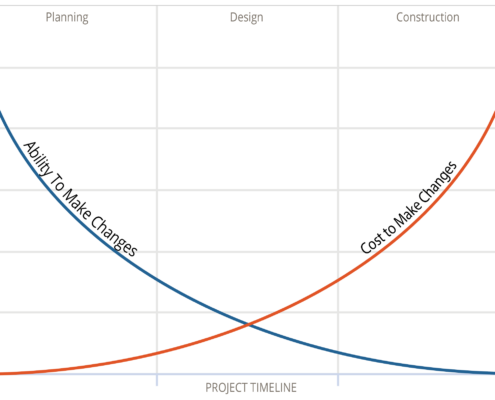
Project timeline versus opportunity for change
The capital costs are typically those most in question. As a project progresses, the ability to influence its overall sustainability and resiliency decreases, while the cost to do so increases. Broad and effective collaboration early in a project can increase the sustainability potential with less impact to cost. The perception of sustainability as a ‘premium’ results from trying to apply sustainability late in development to a business-as-usual project. Beginning discussions about sustainability early provides more opportunities to impact decisions and improve sustainable performance without having significant impacts on the overall project cost. Envision can help project teams to look at tradeoffs to balance ambition with making sound decisions. The most important part is the conversation spurred by questions within the credits. When ideas are discussed early, they could be easier to incorporate and result in little or no additional cost. The primary discussion should always be about adding value to the project, the owner, and the community.
Envision can also help project teams to examine the initial investment vs. life-cycle costs, looking at maintenance costs, operational efficiency, and timing for replacement and refurbishment, as well as innovative ideas and resiliency strategies. Credit LD3.3 Conduct a Life-Cycle Economic Evaluation provides best practices to go beyond looking at total economic impacts to mapping a project’s social, environmental, and financial costs and benefits.
In 2023, ISI undertook a substantial research effort to understand the influence of Envision implementation on project costs. Key trends in the research include:
Justin Waples, Infrastructure Strategic Planning Engineer with Central San, which provides sanitary sewage transport and treatment for the central portion of Contra Costa County, California, notes, “Any project that does not undergo a well-considered planning, chartering and scoping process is likely to be more expensive than a project that has gone through those steps. Identifying opportunities for incorporating Envision into a project at those very early stages will identify early sustainability project enhancements, and likely at no cost. Conversely, trying to tack-on Envision onto a project, once the project has already been scoped, may indeed increase project cost, just like any late scope additions to a project. To add, the old way of thinking about an infrastructure project’s value, in terms of assets financial performance, and level of service performance, needs to evolve. As engineers we need to expand project value metrics for public infrastructure projects, to include the five Envision categories. Doing so will provide validation and clarity for public utility finance professionals, public executives, and elected officials. This in-turn will encourage more engineers to use Envision, and also provide industry momentum for producing more sustainable, more resilient and more equitable projects.”
Myth: It’s all about the award – You have to verify projects to get benefits from Envision.
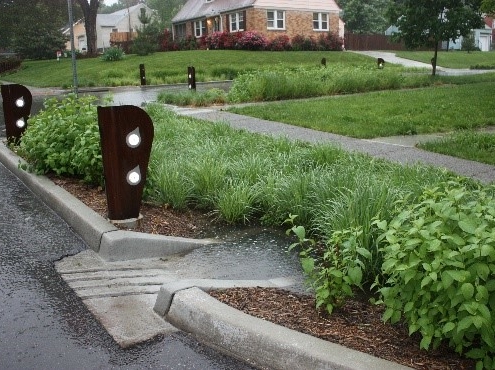
Middle Blue River Green Infrastructure Project, Kansas City, Missouri (Envision Platinum v2, 2016)
Over the 14 years since Envision was introduced, numerous organizations have integrated the framework into their processes – not only to facilitate the opportunity to recognized for an award – but to improve consistency, efficiency, transparency, and innovation, as well as provide a common language around sustainability. Since 2014, KC Water in Kansas City, Missouri, used a Sustainability Playbook developed by the water department to satisfy requirements of a City ordinance supporting the incorporation of sustainable principles outlined in Envision on all City projects. The Playbook for water projects incorporates Envision as a framework for assessing sustainability and resilience for all water projects. During that time, KC Water has verified two projects: Middle Blue River Green Infrastructure Project (Envision Platinum v2, 2016) and Vivion Transmission Main – Chouteau to Brighton (Envision Bronze v2, 2019), and registered the Blue River Biosolids Facility Project.
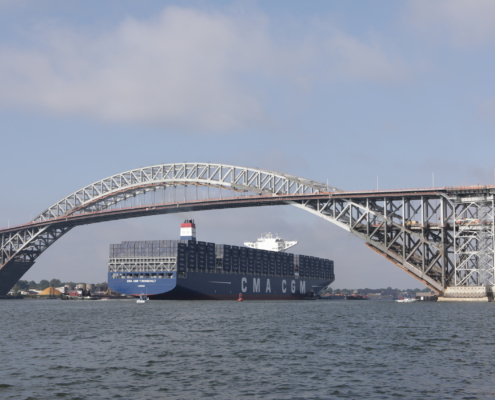
Bayonne Bridge Navigational Clearance Program, New York, New York (Envision Silver v2, 2019)
Resilient and Sustainable Engineering with Port Authority of New York and New Jersey (PANYNJ) stated, “Although an Envision award brings recognition to projects, projects don’t need to receive awards to get benefits from Envision. ISI’s Envision framework guides projects in the direction of integrating sustainable and resilient measures within the project workflow. If a project follows this framework, it will receive benefits from the enhanced coordination and communication. Envision verification is an added benefit for projects that receive an award. PANYNJ’s Sustainable Infrastructure Guidelines (SIG) leverage the Envision framework for internal certification where projects apply the Envision framework but do not pursue formal verification. This process helps the Port Authority streamline the process and approach for applicable credits across all projects. The project teams can then focus their efforts on improving compliance with credits that are unique to the project. For example, all PANYNJ projects have similar compliance for credits in the Leadership category whereas credits from the Climate and Resilience category are project specific.” The Port Authority has two verified projects: Bayonne Bridge Navigational Clearance Program (Envision Silver v2, 2019) and LaGuardia Airport New Terminal B (Envision Platinum v3, 2019). In 2023, the terminal project was the first to complete a post-construction review since the launch of Envision v3 in 2018.
“Although an Envision award brings recognition to projects, projects don’t need to receive awards to get benefits from Envision.”
– Resilient and Sustainable Engineering, Port Authority of New York and New Jersey
Kara Wright, ENV SP, a Sustainability Project Manager with Pinyon Environmental, Inc., notes, “I’ve acted as the ENV SP on project teams where I encouraged the project owner to really consider whether submitting for verification made sense for them. Although there are countless benefits for seeking verification, submitting for the award can be administratively intensive and may promote strategies that maximize points without upholding the original intentions of the project. One client in particular has been applying Envision to their projects for over three years now and has never once vocalized plans to seek verification. Instead, we’ve used Envision to establish baseline performance from which to build department-level sustainability goals, build an alternatives analysis for conceptual designs, and even as a communication tool better express project impacts during comment periods.”
“We’ve used Envision to establish baseline performance from which to build department-level sustainability goals, build an alternatives analysis for conceptual designs, and even as a communication tool better express project impacts during comment periods.”
– Kara Wright, ENV SP, Sustainability Project Manager, Pinyon Environmental, Inc.
Juliana Archuleta, CFM, CSM, ENV SP, Stormwater Administrator, Public Works with Adams County, Colorado, dispels the myth by saying, “It is NOT all about the award. Although it is nice to be publicly recognized, you don’t need a formal stamp of approval to do things right. The implementation of the Envision framework walks you over all areas that need to be considered to design, construct and maintain a sustainable project. Envision provides immediate value and benefits to the environment, to the community and to the economy. Even if an organization is not able to implement all the credits at once. For example, in Adams County, Colorado, we are in the beginning stages of adopting Envision, so only about 4 credits are being evaluated. This partial implementation helps us understand the Envision process and dig deeper on those specific credits, rather than trying to cover all of them at the same time. Our engineering and inspection teams are able to get familiar with this new process and embrace it.”
Envision is a tool that is available for anyone to use to implement more sustainable, resilient, and equitable projects. The necessary tools and resources are available to users with a free ISI user account. ISI also manages a membership program, and training and credentialing programs.
Contact us if you have comments on these myths or if there are other myths we should look into in the future.

